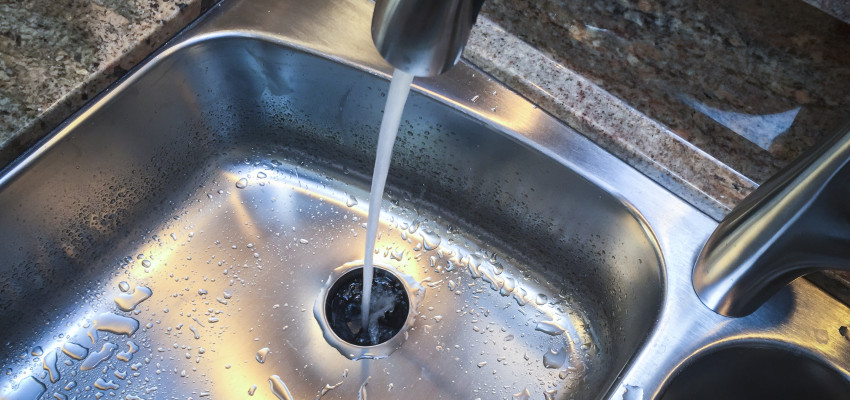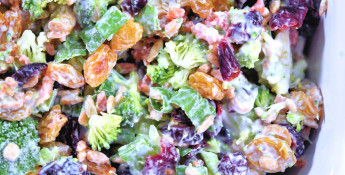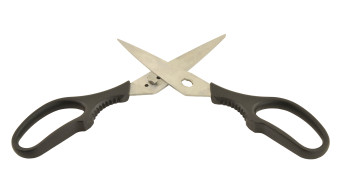By Chef Alli on January 11, 2022
Using and Cleaning Your Garbage Disposal

Our garbage disposals are not as invincible as we might think.
Here’s a helpful list of disposal do’s and don’ts that can help avoid mishaps, provide some guidelines, and offer a few tips for care and cleaning, too.
Plus, you will also find a handy list of suggested food items that should never be put down a garbage disposal.
Please Beware: Coffee Grounds and Eggshells
While both of these items are so seemingly harmless, please save them for the compost pile, NOT your garbage disposal.
Coffee grounds are well known for clogging drains due to the high oil content in the beans.
Eggshells are thin and delicate, yet plumbers claim they are one of the worst items for a disposal since they so easily adhere to the blades, preventing them from working properly.
Believe it or not, that tiny little eggshell can totally and completely jam up a garbage disposal.
Side Note: I have begun sprinkling leftover coffee grounds into my house plants and indoor herb pots, right on top of the soil. As the plants are watered, it presses the grounds further into the soil where the added nitrogen really gives the plants a boost. I also do this every summer with my geraniums to keep them loaded with the biggest, brightest blooms all season.
Citrus Bomb
Nope, your disposal doesn’t need vitamin C, just a bit of crunchy freshening on a regular basis.
Make disposal citrus bombs by placing small pieces of citrus into an ice cube tray and adding white vinegar to freeze into ice cubes. Once the cubes are frozen, place them into a freezer bag for easy access when needed.
When the disposal is running, toss in a couple of the frozen citrus bombs for a good, quick cleaning that really deodorizes.
Making disposal citrus bombs is a great way to use up leftover lemons, limes and oranges that might otherwise be tossed away.
No citrus bombs on hand? Even just a good splash of bottled lemon juice into a running disposal helps with cleaning and freshening.
Water Well After Use
Allow water to run after using your disposal each time. This is vital for the prolonged life of a garbage disposal, truly.
A good rule of thumb is to let the water run for at least one minute after you turn off the disposal, flushing out any remaining food particles.
This one simple step can go a long way toward preventing clogs and keeping pipes open further down the way.
Cold Water Fights Fat
If fatty foods and ingredients make their way into your disposal, be sure to run COLD water as they process.
When oils coagulate and fats get even more solid in form from the cold water, your disposal can break them down into small pieces much more efficiently, so they more easily make their way through the drain and pipes.
Ban All Oil
I know it can seem tempting to pour that hot, liquid fat (oil) right down the drain and into the garbage disposal when you quickly want to dispose of it. Don’t do it!
If this situation does occur, immediately boil a big pot of water, pouring it into the disposal and drain to help flush the oil on down the pipes.
Douse with Dish Soap
A good grease-fighting dish soap helps clean out grime and funky-gunky stuff that tends to gather inside a disposal.
Just squeeze a bit of dish soap directly into the disposal and turn it on; run cold water through for 30 seconds.
Baking Soda Baths
If you opt not to go the route of citrus bombs due to all the racket during use, you may want to opt for a more ear-friendly method of sanitizing your disposal.
When the sink has completely dried overnight, add a good handful (half a cup) of baking soda down into the disposal.
Follow the baking soda with a good splash of white vinegar, then watch for the fizz.
After 30 minutes (and the fizz is long gone) pour boiling water into the freshened disposal. Voila! Clean and fresh. **If your disposal is especially stinky, you may need to do this method a couple of days in a row to remove all the odors.
Don’t Forget the Flaps
Because mold and mildew can accumulate beneath the rubber flaps of the disposal, this is an area that needs cleaned on a regular basis as well.
To clean that area with a brush, use one that has a 2-3” long handle. Load the brush with some bleach gel then scrub under the flaps and also the upper area of the disposal.
Some disposal rubber flaps can actually be removed to be cleaned. Check with the owner’s manual for directions.
Ban All Corrosive Chemicals
Harsh cleaners like drain cleaners and bleach can quickly corrode and damage your plumbing. Use the gentler cleaning methods noted above to keep your disposal fresh and in good working order.
More Items Your Garbage Disposal Should Be Shielded From
Hard food items like seafood shells, animal bones, popcorn kernels and even nuts can be way too much for your disposal to handle. Deposit these items into the trash bin, not the disposal.
No fibrous foods should go into the disposal such as raw asparagus, large pieces of onion skins, celery, banana peels, etc. These types of foods can put too much wear and tear on the disposal blades since they are easily caught there, often remaining stuck.
Avoid placing large amounts of popcorn, pasta and rice into the disposal. These types of food expand as they absorb water, possibly leading to clogs.
Because flour coagulates when mixed with water (yep, straight-up glue!), it should never be placed into a garbage disposal. This can make a big blockage that also catches other foods to make an even bigger drain clog. Instead, toss any type of flour (and dough) right into the trash bin.




